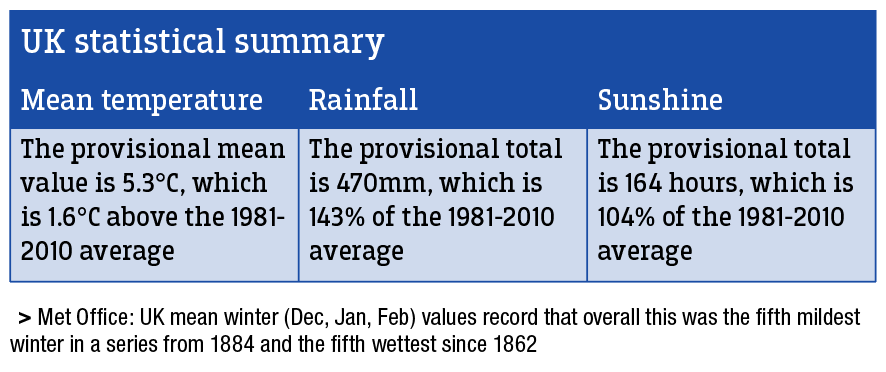It’s been a wet and warm winter and unusually so.
• www.agrii.co.uk • 08456 073322 • julian.searle@agrii.co.uk
Unless temperatures fall we can expect bud burst in vines before the end of the month. Statistics from the Met office about the weather, if we should need them, are illuminating:
In southerly grape growing regions rainfall was nearer 170% of ‘normal’. February took the prize; rainfall totals were well above average everywhere, with many places recording more than three times the average. It was the wettest February (and fifth wettest of any month) in a series from 1862; the UK figure was 237% of average.
In agricultural terms excess winter rainfall (EWR) is of interest. EWR is the amount of rainfall the land receives after the soil profile becomes fully wetted in the autumn (field capacity) and before the end of drainage in the spring (around the end of March). In most southerly regions this has been given as high – over 250mm EWR.
The impact on our vineyards and our operations is significant. Early interventions to remove prunings, control weed under the vine and prepare new ground for planting on many sites isn’t an option and in other Top and Soft fruit crops necessary early crop protection is delayed.
A feature of wet winters is the loss of soil nutrients from leaching. Nitrogen is poorly held and on lighter soils other nutrients too. Yield in some vineyards has been good for two seasons; couple that with winter losses and you should expect some nutrient depletion. Review your nutritional requirements in readiness to apply when ground conditions improve. Analyse the soil every three years and apply P, K, Mg accordingly or a maintenance dressing with something like Agrii Fruit50. Nitrogen is as important as any other element and is needed for every cycle of production – healthy wood, leaf, canopy and yield. As with all nutrients it is best applied to the soil and pre-flowering to moist soils that can absorb it.
Long term, raising soil organic content by planting cover crops and/or applying compost or organic fertilisers has cost saving benefits for both the grower and the environment – helping to reduce nutrient leaching and maintaining a healthy soil structure. The release of nitrogen from organic matter (mineralisation) is slow and takes place over a period of months to years. For every percent soil organic matter content over a low to average level (<4%), 10kg nitrogen per hectare may be held over the winter and released for cropping so that at circa 8% content this represents the annual requirement for vines.
Plant roots in soils that have been at field capacity for prolonged periods will be damaged and in this situation some root death can be expected. Where vines are unable to adequately absorb nutrients from the soil, foliar nutrient applications become more important and may be prudent this spring.
Controlling over wintering weed cover wasn’t possible in the autumn and effective cultivation conditions may be delayed. In this situation early use of glyphosate comes into its own to reduce crop competition. The current EU licence for glyphosate expires on 15 December 2022, so we have it for three more seasons.
Be prepared for early bud break, frost protection where possible and first spray treatments. Eriophyid mite damage leading to bud blindness, unfruitfulness and weak canopies was a significant problem on some sites last season and a common incidence in many. The spray timing to control it is early and very specific.
Please get in touch with your Agrii contact
for more information.




